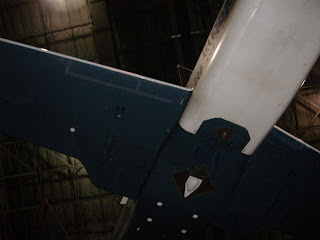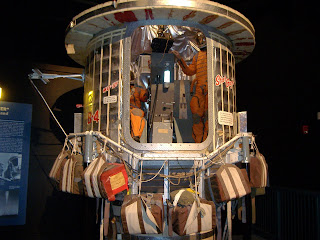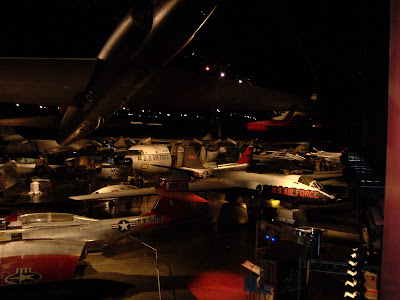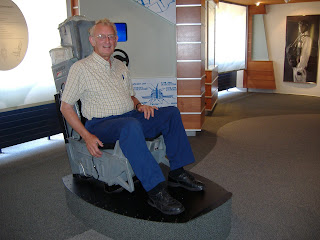National Aviation Hall of Fame
Air Mail:
We started our day with this section.
The U.S. Signal Corp purchased the 1909 Wright Military Flyer for $30,000. It is the world's first heavier than air military craft. It met the following specifications: carry 2 people, fly for at least an hour, take-off & land from same spot, fly at speed of 40 mph.
In 1918 the USPS takes over air mail service from Army Signal Corps using newly hired Civilian pilots, surplus post-war "Jennies." The USPS discovered that flying mail was hazardous to your health. Air Mail pilots had life expectancy of 900 flight hours. They had to fly in all weather with no radios or navigational aids.
By 1927 all air mail was via commercial contractor. Two of the routes went to Henry Ford, auto manufacturer, and his fledgling air craft company. He later manufactured bombers for WWII.
Want to be an inventor???
Time tested scientific method:
Observe
Develop theory to explain what you have observed.
Use theory to make a prediction.
Perform experimental test of the predictions.
Cabbage Patch Rocket:
During 1920's Robert Goddard, pioneer in the development of rocketry, conducted experiments in propulsion. He launched his liquid fueled rocket in 1926 from a cabbage patch at his Aunt Effies' home in Massachusetts!
Modern Flight Gallery
Korea and southeast Asia Conflicts are the time frame for the planes in this section:

The underside of this plane shows that it is carrying cameras to take reconnaissance photos for the military. In the 1950's two cameras(K-22) with 40" focal length telephoto lens were used. Each camera could take 200 exposures on its 9" X 9" format. A K-17 camera was also available. It was fitted with telephoto lens up to 24".
Photos that have been classified for 45 years are on exhibit. They were taken of airfields, submarine pens & factories in Soviet Union, North Korea and China.
By using 2 photos taken with slightly different perspective a stereoscope created the mental expression of a 3-dimensional model. Now we have Google Earth!
Korean Conflict:
The B-29 Bomber was used to destroy major military and industrial targets important to enemy forces. We could walk through the body of this bomber. There was a large round tube for the personnel to slide through to get over the wing structure and into the tail of the bomber to load the bombs.
The first large-scale use of the helicopter for aerial evacuation of wounded personnel and rescue from behind the enemy lines
Battle Hymn:
This book by Dean Hess is his personal story. It was made into a motion picture starring Rock Hudson. Dean Hess was an ordained minister of Christian Church, who enlisted during WWII. He was called back to duty, stationed in Korea to train Korean pilots. While there he started an unofficial program for giving food and shelter to the real victims of war--the children who had lost their parents and homes.
In the midst of an offensive he requested help to evacuate hundreds of children from the area of fighting to an island. It was called Operation Kiddy car.
POW:
The exhibit shows the horrible conditions the POW had to endure. To maintain strength and a sense of community they found ways to communicate. One way was by tapping walls with a message using a code. Abbreviations were common. An example would look like your text message!
They showed ingenuity in making articles from soap, toothpaste, bread, charcoal and whatever they could get their hands on.

Auro Car
In the early 1950's an experimental flying saucer shaped aircraft was produced. Nicknamed "Star Wars!" It did not make it! If it flew more than 3 feet above ground it was uncontrollable!

Hey, VR's! We found the missiles that are stored underground in South Dakota!!!!
The picture shows the rockets that launched missiles and satellites from underground silos.
Did you know that our cordless tools were experiments used in space?
One not successful experiment was a spring-powered shaver with an attached bag to collect whiskers. Common brushless shaving cream did the job without any development!
Food for eating in space was an interesting exhibit. The first food was dehydrated. A peanut butter sandwich was shrunk down to a 1 inch square! Water would have to be added to the bags and allowed to soak into the food before being eaten.

This "Stargazer" gondola was used with a helium balloon for testing high altitude flights in 1959-1962. Joseph Kittinger, Jr did high altitude jumps from balloons to test the affects of high-altitude bail outs on pilots. He joined astronomer, William C. White and rose to 82,200 feet, hovered for 18 1/2 hours checking variations in the brightness of star images caused by the atmosphere.
Cold War Gallery:
 We took a picture from the balcony in the Missile & Space Gallery to give you a feel for what the museum looks like. This is just a very small part of the Cold War Gallery hangars!
We took a picture from the balcony in the Missile & Space Gallery to give you a feel for what the museum looks like. This is just a very small part of the Cold War Gallery hangars!  This is the B-36! Papa Jim remembers hearing them and seeing them fly over their farm when he was growing up. It was the largest mass produced piston engined aircraft ever made. Had the largest wing span in a combat air craft ever built. had 6 engines each driving an immense 3 bladed propeller. Was the first operational bomber with an intercontinental range.
This is the B-36! Papa Jim remembers hearing them and seeing them fly over their farm when he was growing up. It was the largest mass produced piston engined aircraft ever made. Had the largest wing span in a combat air craft ever built. had 6 engines each driving an immense 3 bladed propeller. Was the first operational bomber with an intercontinental range. So much history under one roof!
What can we learn from it?
To see stories about real people dealing with the situations during their lives and using what was available or inventing what was needed to adjust to them, makes me aware of my responsibility to use what God has given me to accomplish His purpose for my life in the time He allows me in this world!







